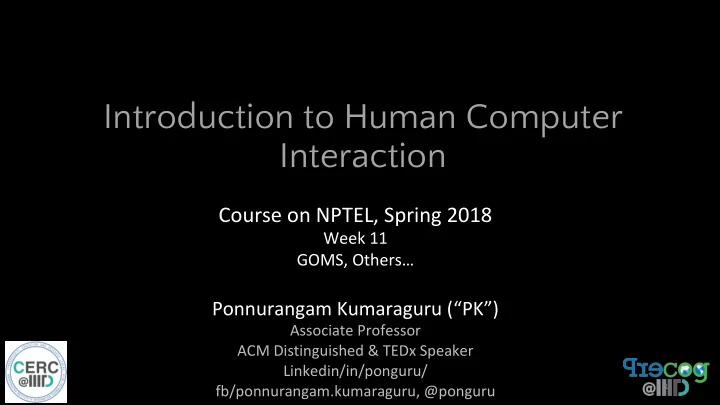

Introduction to Human Computer Interaction Course on NPTEL, Spring 2018 Week 11 GOMS, Others… Ponnurangam Kumaraguru (“PK”) Associate Professor ACM Distinguished & TEDx Speaker Linkedin/in/ponguru/ 1 fb/ponnurangam.kumaraguru, @ponguru
Deciding on Data to Collect ● Two types of data ● process data ● observations of what users are doing & thinking ● bottom-line data ● summary of what happened (time, errors, success) ● independent and dependent variables 2
Which Type of Data to Collect? ● Always focus on process data first ● gives good overview of where problems are ● Bottom-line doesn’t tell you where to fix ● just says “too slow”, “too many errors”, etc. ● Hard to get reliable bottom-line results ● need many users for statistical significance 3
Comparing Two Alternatives ● Between groups experiment ● two groups of test users ● each group uses only 1 of the systems ● Within groups experiment ● one group of test users ● each person uses both systems, randomized ordering ● can’t use the same tasks or order (learning) ● Between groups requires many more participants than within groups 4
Discount Usability Engineering ● Reaction to excuses for not doing user testing ● “too expensive”, “takes too long”, … ● Cheap ● no special labs or equipment needed ● the more careful you are, the better it gets ● Fast ● on order of 1 day to apply ● standard user tests may take week or more ● Easy to use ● some techniques can be taught in 2-4 hours 5
Examples of Discount Usability ● Low-fi prototyping ● Action analysis ( GOMS ) ● Heuristic evaluation ● On-line, remote usability tests ● Walkthroughs ● put yourself in the shoes of a user ● like a code walkthrough 6
Action Analysis & GOMS ● Basic idea: uses a cognitive model to predict quantitative (time) and qualitative use for expert users ● GOMS stands for ● G oals – high level goal (and subgoals) in layman terms ● O perators – low level, e.g. button press, menu select ● M ethods – well-learned sequences (e.g., delete para) ● S election – rules for deciding which method to use ● Input: detailed description of UI / task(s) ● list steps hierarchically ● Output: quantitative time measures 7
Stuart Card, Thomas P. Moran and Allen Newell, 1983 8
Non-Computer Example of GOMS ● Goal (the big picture) ● go from hotel to the airport ● Operators (specific actions) ● locate bus stop; wait for bus; get on bus; ... ● Methods ● walk, take bus, take taxi, rent car, take train ● Selection rules (choosing among methods) ● Example: Walking is cheaper, but tiring and slow ● Example: Taking a bus is complicated abroad 9
GOMS Output ● Execution time ● add up times from operators ● assumes experts (mastered the tasks) ● error free behavior ● absolute accuracy ~10-20% 10
Using GOMS Output ● Ensure frequent goals achieved quickly ● If you want to make sure that a highly repetitive task is done as quickly as possible, use GOMS ● Making hierarchy also of value ● functionality coverage & consistency ● does UI contain needed functions? ● consistency: are similar tasks performed similarly? ● operator sequence ● in what order are individual operations done? 11
Applications of GOMS ● Comparing different UI designs ● Estimating number of steps it will require ● Estimating amount of time ● Profiling an existing UI ● Building a help system ● Modeling makes user tasks & goals explicit ● Can suggest questions users will ask & the answers 12
Tradeoffs of Using GOMS ● Advantages ● Gives quantitative measures ● In some cases, can be less work than user study ● Easy to modify when UI is revised ● Disadvantages ● takes lots of time, skill, and effort ● research: tools to aid modeling process ● only works for goal-directed tasks ● not problem solving or creative tasks (design) ● assumes expert performance w/o error 13
Heuristic Evaluation Process ● Evaluators go through UI several times ● inspect various dialogue elements ● compare with list of usability principles ● consider other principles/results that come to mind ● Usability principles ● Nielsen’s “heuristics” ● supplementary list of category-specific heuristics ● Ex. competitive analysis & user testing of existing products ● Ex. privacy, social media, mobile 14
Heuristics (Original) H1-1: Simple & natural H1-6: Clearly marked dialog exits H1-2: Speak the users’ H1-7: Shortcuts language H1-8: Precise & H1-3: Minimize users’ constructive error memory load messages H1-4: Consistency H1-9: Prevent errors H1-5: Feedback H1-10: Help and documentation 15
More Heuristics ● H2-1: Visibility of system status ● H2-2: Match between system & real world ● H2-3: User control & freedom ● H2-4: Consistency & standards ● H2-5: Error prevention ● H2-6: Recognition rather than recall ● H2-7: Flexibility and efficiency of use ● H2-8: Aesthetic and minimalist design ● H2-9: Help users recognize, diagnose, and recover from errors ● H2-10: Help and documentation 16
Gestalt principle – Visual design 17
Thank you note… ● Thank you for taking the course.. ● Good luck.. ● Was great to meet some of you in person in the last 10 weeks. ● Hope to see you in future courses or in person… 18
Ponnurangam Kumaraguru (“PK”) Associate Professor Indraprastha Institute of Information Technology New Delhi – 110078 pk@iiitd.ac.in precog.iiitd.edu.in
Recommend
More recommend